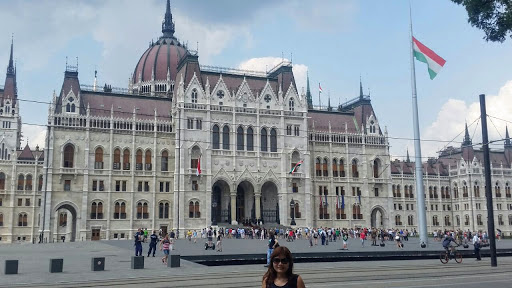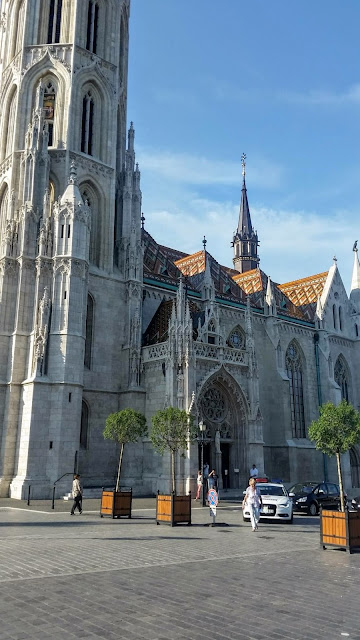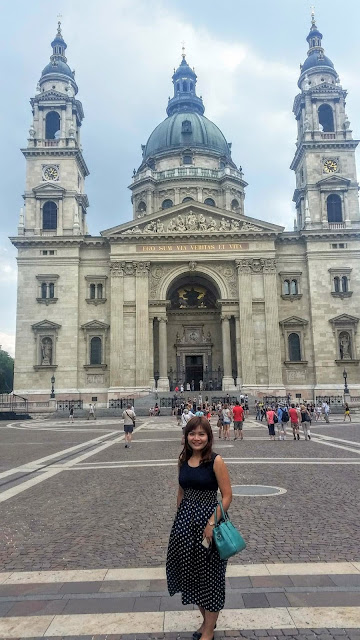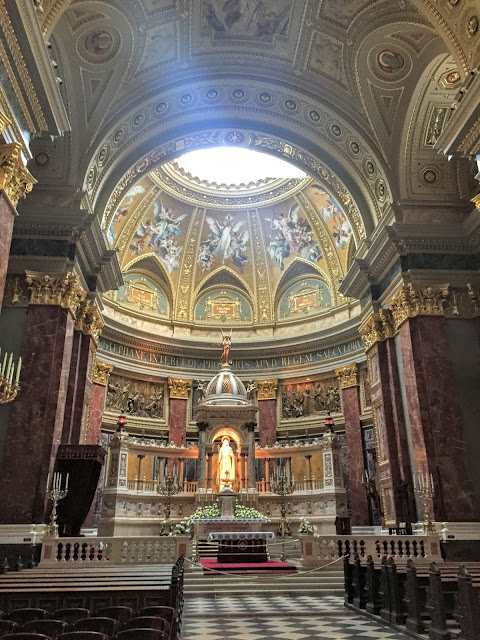I think towards the later part of the trip, I began to love the places I visited more and more. I love Budapest! However, my first impression was totally different:
It was a chilly, wet, dark and gloomy night when we arrived at Budapest Keleti railway station. We decided to hail a cab to take us to our Airbnb accommodation. I was outside attempting to get a cab, but failed as there were no cabs at all. I headed in, to the vestibule, to inform Khuns of our predicament, then, I saw a burly, thuggish-looking man, talking angrily in Hungarian to her!
"What the f*** is going on!? OMG.. he is going to kidnap us and sell us to some sick tycoon!!" the thoughts racing through my head. (I am so sorry, but this is mainly the influence of that horrible Hostel movie I watched whilst in university! It is buried deep in my brains and resurfaces once in a while!)
I went closer and saw that he is a taxi driver (he was wearing the taxi driver uniform). He then walked away furiously. Khuns then told me she asked him if he could drop us at our accommodation but, we suspect, he didn't know the address and Khuns couldn't describe it, then he got angry.
If that wasn't enough, (we finally got a cab using the Budapest taxi app, which Khuns smartly downloaded before arriving), as we approached our accommodation, the place looked deserted (although before we booked, we checked that the location is in the central area) and the apartment looked super dodgy (from the outside), thankfully the inside was pristine! Before I slept, I was like, "Oh man, how am I going to survive these next few days?!"
However, the next few days were glorious!! Our accommodation location is central and it isn't dodgy at all! Lesson learnt: Always give second chances!
 |
| Our accommodation area. The Ferenciek tere area (Pest side) |
Budapest is diverse - The Buda side is different from the Pest side (Budapest is made of Buda and Pest, which are separated by the Danube). The look of the city and the architecture are unlike that of Western Europe. It is very European but with a Hungarian twist and can only be found in Budapest!
 |
| Budai várnegyed (Castle District) |
 |
| Matthias Church |
 |
| The church on the left and the Halászbástya (Fisherman's Bastion) on the left |
 |
| Halászbástya (Fisherman's Bastion) - Neo-Gothic and neo-Romanesque style |
 |
| The seven towers represent the seven Magyar tribes that settled in the Carpathian Basin in 896 |
 |
| View of the Matthias Church from the Halászbástya (Fisherman's Bastion) |
 |
| Monument of Prince Eugene of Savoy in the Budavári Palota (Buda Castle) |
 |
Budavári Palota (Buda Castle)

You should witness the change of guards. There is a cute little dance move that takes place. Very cute!

Monument of Prince Eugene of Savoy in the Budavári Palota (Buda Castle) |
 |
| One of the architects of the castle - Alajos Hauszmann |
 |
| Matthias Fountain |
 |
| The lower chapel of the medieval castle |
 |
| Traditional Royal Hungarian Costume |
 |
| View of the famous Széchenyi Chain Bridge from the castle |
 |
| View of the Hungarian Parliament Building |
 |
| View of Castle District |
 |
| View of the Pest side from the riverbank at the Buda side |
There is also the Hospital in the Rock, Castle District, that is worth visiting.
The Buda side is more traditional, the Pest side is more modern.

 |
| View of Buda Castle from the bridge |

The Hungarian People are friendly - especially the younger generation. People came up to us voluntarily to offer help. The older generation is not as open, but this could be due to the fact they were under communist rule from 1944 up to 1989.
Another thing I love about Hungary is that no Magyar looks similar. Some Hungarians look Turkish, some Celtic - so diverse! This is because, Hungary is located in the Carpathian Basin - central. There were migration of many tribes, millions of years ago - the Celtics, Germanic, Turks, to name a few. Hence, resulting in mixed appearances.
 |
| Traditional Hungarian folk dance |
 |
| Potato with paprika - The Hungarians use a lot of paprika. |
 |
| Gundel Palacsinta filled with nuts and chocolate sauce. |
 |
| Tokaji Aszú. Sweet wine from the Tokaj wine region. Luscious and has a light texture (not viscous!) |
Budapest is one of the cheapest European destinations. A bottle of 1.5-litre mineral water costs RM 0.20 (Euro 0.04/ USD 0.05) - insane isn't it!
The currency used in Hungary is not the Euro, it is the Hungarian Forint.
Isn't Hungary in the European Union (EU), why don't they use the Euro?
Well, it's because they are not part of the Eurozone. Say What?! Confused?
Let me attempt to explain with my very brief understanding:
European Union (EU):
- A politico-economic union of 28 member states (may be down to 27 in 2 years time..lol).
- It is an internal single market through a standardised system of laws that apply in all member states.
- EU policies aim to ensure the free movement of people, goods, services, and capital within the internal market, enact legislation in justice and home affairs, and maintain common policies on trade, agriculture, fisheries, and regional development.
Eurozone:
- A monetary union of 19 of the 28 European Union (EU) member states which have adopted the Euro as their common currency controlled by the European Central Bank (ECB) - and many different governments setting their own fiscal policies (the cause of economic crisis in some Eurozone countries).
- To join the Eurozone, there are certain criteria the countries must meet in terms of inflation, government budget deficit, debt-to-GDP ratio, exchange rate stability and long-term interest rates.
Let me introduce one more:
Schengen Area
- 26 European countries that have abolished passport and any other type of border control at their mutual borders.
- It mostly functions as a single country for international travel purposes, with a common visa policy - which Hungary is a part of.
- Your passport will be checked upon entry into any country in the Schengen Area, and exiting from any country in the Schengen Area to a country not part of the Schengen Area. Passports are not checked when travelling within the area.
- Some passports require a single visa to enter countries in the Schengen Area. Thankfully the Malaysian passport does not require a visa :D (This is NOT due to the fact that Malaysia is a Commonwealth country).
Budapest is untouched and not commercialised! It is a big city but it is not crowded. It is unique. Some may think it is 'backward' as it was a communist state until 1989 - but it is not! It is quite modern and the people are extremely receptive and helpful! I adored my time in this elegant city.
From the Magyar land, we headed out of the Schengen Area to Zagreb!
Pozdrav Zagreb :)
































































